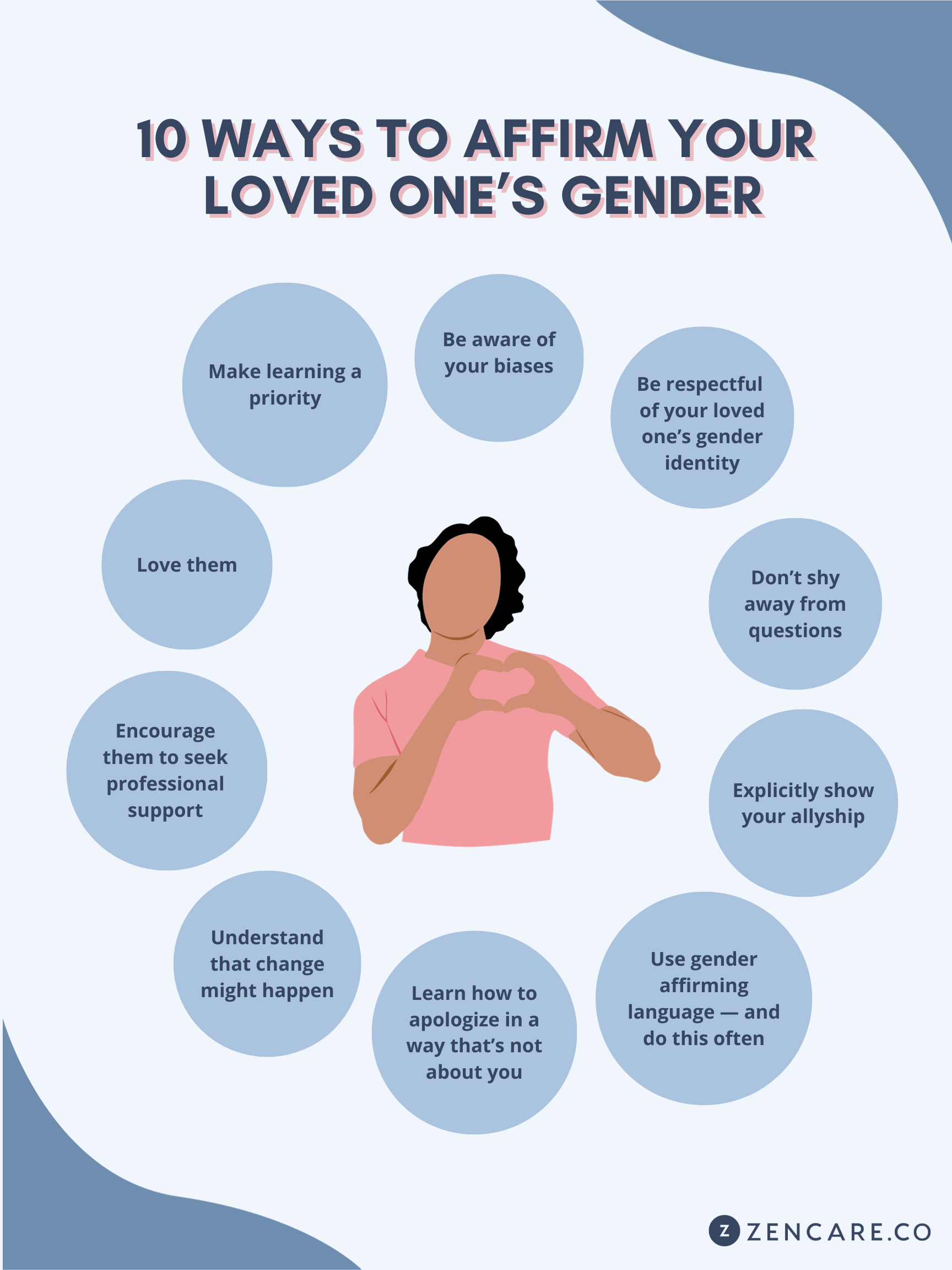While the pride flag shows a rainbow of six distinct colors, the true array of color is a spectrum. In this spectrum, colors vary in shade and tone, and colors blend together at their edges. For many people, gender is the same. While for most of the modern era, gender was thought of as a binary — “there are men and there are women” — gender is now understood as fluid and diverse.
When someone is gender fluid, gender non-binary, or if they identify as a gender that’s not the one assigned to them at birth, it can impact all areas of their lives, including family relationships, romantic or sexual relationships, and friendships. For many, affirming the gender of a loved one can be a significant part of their journey and lead to a better sense of support and acceptance.
We’ve gathered 10 ways to affirm your loved one’s gender so you can continue to grow your relationship.

What does it mean to be gender affirming?
To understand the term “gender affirming,“ we must start with gender and gender-related terms. Gender is not always the same thing as sex, which describes a label that a doctor assigned you at birth based on your physical attributes and chromosomes. Gender is the cultural and sociological categorization of a person into man and woman. In the past, these were the only two options, which is often called the gender binary. While society still has leagues to go when it comes to knowledge about and acceptance of gender fluidity and gender expression that doesn’t match sex, contemporary times are more open to people expressing different genders to the ones assigned at birth.
For someone to be gender affirming, they’re acting in a way that makes them feel more closely aligned with how they want to express their gender. This might mean getting a gender affirming haircut or using a different name. For someone to be gender affirming for a loved one, it means that they treat them according to their gender expression — and more than that, they explicitly respect and celebrate their gender and gender expression, even if that’s not the gender that was expressed earlier in the relationship.
Impact of gender affirmation
The impact of gender affirming experiences cannot be understated. Many trans, gender fluid, or gender non-binary people face unacceptable levels of discrimination, which can lead to increased risk of poverty, adverse health outcomes, and even suicidal ideation. The opposite of being discriminatory, in this case, is to be gender affirming.
To be gender affirming for a loved one, you’re communicating that you fully and wholly accept them for who they are, and you don’t want them to change. To extend upon that acceptance, you also cherish them and believe that the person they are deserves love. Being gender affirming can contribute to the growth of your relationship with your loved one, and is a way that you can support their overall well-being.
How to be gender affirming
Because gender affirming experiences can be essential in how to connect with your loved one, here are some ways to be gender affirming:
Make learning a priority
If you don’t feel confident in your knowledge and understanding of gender, gender fluidity, or what it means to be trans, learning about these topics is a good start. There are many excellent resources available online (some listed below), as well as books and documentaries. You can also increase the amount of content that you take in, whether that’s books, websites, social media accounts, news sources, or more. This can help you learn not only about the topic but also the current discourse around the topic. Remember, it’s not someone else’s burden to educate you on topics like this, so taking the initiative to do your own research is important.
Be aware of your biases
It’s our great hope that future generations will be raised in a way that does not enforce harmful biases and assumptions about people who have diverse genders or gender expressions. Unfortunately, you were probably raised with biases, as the majority of people are. While it’s not your fault, it is highly impactful to become aware of these biases or assumptions and to actively fight against them.
To combat these biases, take the time to pause everyone once in a while and ask yourself if your thoughts or feelings could possibly be informed by society’s general attitudes or rhetoric about a specific group of people.
Be respectful of your loved one’s gender identity
Being respectful of your loved one’s gender identity can include affirming their name and pronouns, should they wish to avoid their “deadname” or change their pronouns. It’s important to understand that these changes aren’t solely based on preference, they’re a critical aspect of a person’s experience.
Don’t shy away from questions
The best way to understand what your loved one needs you to do to help them feel comfortable in their gender or gender expression is to ask them. You can ask them what pronouns they would like you to use or if they have another name. Questions are conversation-openers, and asking your loved one can be a more straightforward way of learning, rather than taking a guess. At the same time, be thoughtful about what questions you’re asking and try not to ask questions that can be experienced as accusatory, invasive, or disrespectful.
Explicitly show your allyship
Not only should you be gender affirming for your loved one, but for the whole trans, gender fluid, or gender non-binary community. Explicitly showing your allyship can look like getting involved in advocacy work, volunteering with LGBTQ+ organizations, and especially standing up for people in situations that aren’t affirming, even if they aren’t physically present. You can even do these things together, which not only promotes your affirmations but can be a fun bonding activity.
Use gender affirming language — and do this often
Sometimes, it can feel more comfortable to avoid using pronouns or names if you aren’t feeling confident you’ll nail it. Chances are, however, that your loved one will notice this avoidance. After confirming with your loved one what to call them, use their pronouns and name often, especially to other people. This can show that you’re not only understanding but that you aren’t ashamed of them or who they are.
Learn how to apologize in a way that’s not about you
You will probably make mistakes, whether that’s in language or assumptions. Giving a sincere apology can be an effective way to overcome and learn from these mistakes, though it’s important to avoid making your apology about you. This means listening before speaking and focusing the conversation more on your loved one’s experiences, and how you plan to change your behavior, rather than an explanation of your intentions.
Understand that change might happen
Being patient with your loved one is of paramount importance when affirming their gender. They may go through periods of uncertainty about their gender or expression, which can include the need to experiment with different names, pronouns, personal style, identity, and more. This can take time and can also be a highly emotional experience for them, especially if there is trauma to unpack related to their gender. Having regular check-ins can be a way to support them through their journey and to affirm that what they’re going through is worthwhile.
Encourage them to seek professional support
Your loved one may benefit from mental health services provided by a credentialed therapist. Therapy can be a supportive space for them to talk openly about the challenges they face or work through painful memories. In the Zencare therapist directory, search for therapists in your area using the Specialties filter for “LGBTQIA, gender, & sexuality topics.” Therapists with this speciality generally have additional training and extensive experience in working with this population, and can be a great addition to a support system. They can also filter by Identity for a therapist who also identifies as “Trans or Non-binary” if they’d feel more comfortable seeing a therapist who shares that identity!
Lastly, love them
Showing you love them, however that looks for you or them, is the most important way to affirm the gender of someone you care about. Knowing that they have your love, your loved one can internalize that they are lovable despite the discrimination or biases they might face from other members of society. Your relationship does not need to revolve around gender, but gender does play a huge part in the ways that people connect with one another. That being said, don’t forget to focus on having fun and engaging in meaningful conversations in your family, romantic, sexual, or platonic relationship.
Additional resources
Education
- National Center for Transgender Equality Education and advocacy on trans topics, with a stellar blog.
- Human Rights Campaign LGBTQ+ educational resources centering around rights, including a transgender and non-binary people FAQ page.
- Mental Health America National nonprofit dedicated to the promotion of mental health, well-being, and illness prevention
Legal
- Transgender Law Center Provides legal services for people in the transgender community, including advocacy and policy work, litigation, and support groups.
Mental health and well-being
- TransPulse Database of gender affirming medical and mental health clinicians, as well as forums and a suicide chat line.
- Trans Lifeline Hotline run by trans peers to ensure that individuals can remain safe. They also provide microgrants for the trans community that can be used for legal or medical fees.
- Trevor Project Counseling services, including chat services, hotline, and a text line.
Financial
- Point of Pride Provides financial support for HRT or gender affirming surgeries.
- Jim Collins Foundation Fund that supports gender affirming surgeries.
- Out2Enroll Service to help trans individuals enroll in health insurance.
